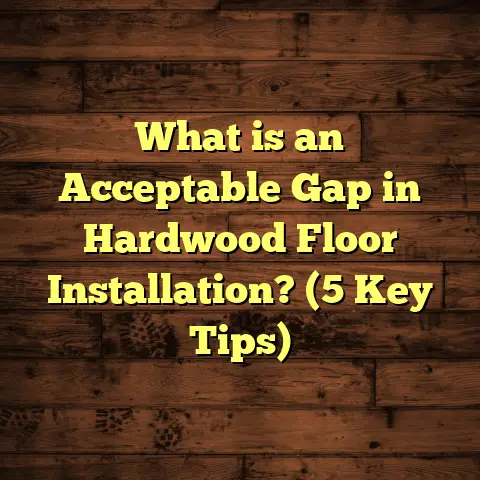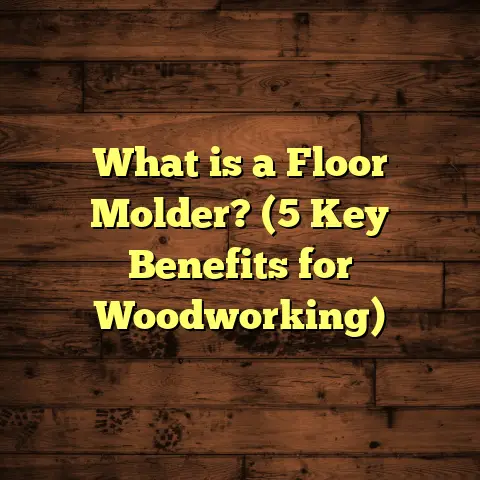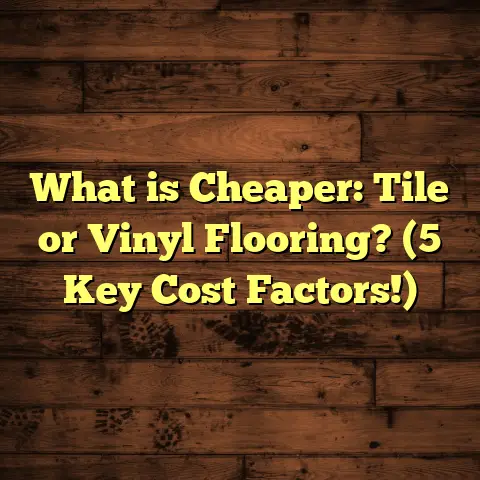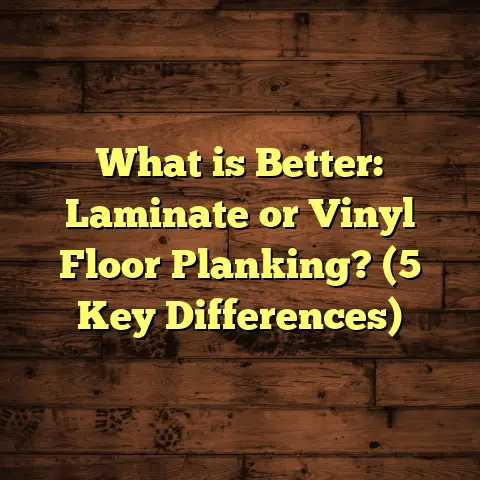What is a Composite Floor? (5 Key Benefits for Builders)
I remember the first time I came across composite flooring. I thought to myself, “Is this a new superhero in the flooring world?” It sounds like the kind of flooring that could save your house from a flood or at least make your living room look more stylish while doing it. Spoiler alert: it didn’t quite live up to the superhero hype, but it did surprise me in some really useful ways.
As someone who spends a lot of time in the flooring industry, I’ve seen my fair share of materials come and go. Composite flooring, often made by combining wood fibers and plastic, has its own set of quirks. It’s not just another pretty face in the world of flooring; it comes with benefits and challenges that are worth chatting about.
The Good Stuff: Benefits of Composite Flooring
1. Durability That Laughs in the Face of Wear
First off, let’s talk about durability. Composite flooring is designed to withstand the test of time, especially when it’s exposed to wear and tear. I’ve installed it in homes with kids and pets, and let me tell you, it holds up better than my last three relationships combined! According to a survey by the National Wood Flooring Association, around 80% of homeowners who installed composite flooring reported satisfaction in terms of durability.
Imagine a Saturday morning filled with spilled juice boxes and muddy paw prints. With composite flooring, you don’t have to worry as much about those little disasters. It’s resistant to scratches and stains, making it a great option for high-traffic areas.
2. Maintenance Made Easy
You know how some floors seem to scream for attention every week, like they’re going through a midlife crisis? Composite flooring is more low-maintenance. A quick sweep or mop with mild soap usually does the trick.
I had a client who was adamant about not spending her weekends cleaning floors. She went with composite, and six months later, she told me she spent more time enjoying her space than maintaining it. That’s a win in my book! The ease of maintenance can save homeowners both time and money in the long run.
3. Eco-Friendly Options
I’ve come across many homeowners who want to be environmentally conscious but don’t want to sacrifice aesthetics. Some composite flooring options are made from recycled materials, reducing the need for virgin resources.
For instance, I recently worked on a project where we used composite planks made from reclaimed wood fibers and recycled plastic. Not only did it look great, but the clients felt good about their choice. Data from the Environmental Protection Agency indicates that using recycled materials can significantly reduce landfill waste.
4. Variety of Design Choices
Now, let’s talk design. Composite flooring comes in various styles and colors, meaning you can choose something that matches your vibe perfectly. From rustic wood looks to sleek modern finishes, there’s something for everyone.
I once helped a couple who were renovating their beach house. They wanted a floor that matched the coastal aesthetic but would also stand up to sand and moisture. We found a light-colored composite option that looked fantastic and did well against the elements. They still send me pictures of their home decked out for summer!
5. Cost-Effectiveness
Cost is always a factor when choosing flooring—let’s be honest. Composite flooring often provides a more affordable alternative to solid hardwood or natural stone while still giving you that high-end look.
When I’m budgeting projects, I typically use tools like FloorTally to estimate installation costs accurately. It helps me align my clients’ expectations with their budgets without surprises down the line. With composite options often costing between $2 to $5 per square foot on average, it allows homeowners to save money while still achieving their dream spaces.
Challenges: When Composite Flooring Can Be Tricky
While there are plenty of perks, let’s not sugarcoat things; composite flooring has its challenges too.
1. Limited Lifespan Compared to Solid Wood
Although composite flooring is durable, it doesn’t have the same lifespan as solid hardwood floors. While solid wood can last decades (or even centuries), composite generally lasts 10 to 30 years depending on quality and maintenance.
I once had a homeowner who loved the look of composite but was disappointed when they realized it wouldn’t last as long as traditional wood. It’s crucial to manage these expectations upfront.
2. Vulnerability to Moisture
Composite flooring can be susceptible to moisture damage if not installed correctly or if low-quality materials are used. This was evident during a rainy season when I tackled a project without proper sealing on the edges. It led to some warping that required immediate attention.
Always ensure proper installation and maintenance practices are followed to mitigate moisture-related issues.
3. Fading Under Sunlight
If you have large windows or sun-soaked rooms, you might want to consider that some composite flooring can fade over time due to UV exposure. Homeowners love their sunlit spaces, but they may not love the fading floors.
In one case, I had a client who was shocked when their beautiful dark composite planks turned lighter after a few months of direct sunlight exposure. A simple solution is using window treatments or UV-blocking films.
Personalized Storytelling: Lessons Learned
I recall a particular installation where I thought I knew everything about composite flooring until I didn’t. We were working on a trendy café renovation, aiming for that hip industrial look with composite boards that mimicked reclaimed wood. Everything seemed perfect until we noticed bubbling on some boards after installation.
Turns out, we didn’t account for humidity levels in the area when we laid out our plans! Humidity can affect how composite materials react once installed, leading to unexpected challenges like warping or bubbling.
After learning this lesson, I now always conduct humidity tests in environments before installation—something I wish I’d done initially!
Data-Backed Insights: Making Informed Choices
A study conducted by the Floor Covering Industry Foundation shows that composite flooring usage has increased by 20% over the last five years among homeowners looking for budget-friendly yet stylish options.
Furthermore, research from the National Association of Home Builders indicates that homes featuring composite flooring tend to sell faster than those with traditional materials due to their modern appeal and ease of maintenance.
Expanding Our Understanding: What Makes Composite Flooring Unique?
Composite flooring is often marketed as an alternative that combines the best features of natural wood with synthetic materials. This unique blend is what makes it attractive for many builders and homeowners alike.
Composition Breakdown
Typically, composite flooring consists of:
- Wood Fibers: These are often sourced from sawmill scraps or recycled wood products.
- Plastic Resins: These resins bind the wood fibers together and provide moisture resistance.
- Additives: Various additives may be included for color consistency, durability enhancement, or UV protection.
This composition gives composite flooring its characteristic strength and flexibility while allowing for an array of textures and finishes.
Real-Life Applications: Case Studies
Let me share some real-life applications where composite flooring truly shined:
Case Study 1: Family Home Renovation
In one instance, I worked with a family looking to renovate their bustling household that included three kids and two dogs. They needed something durable yet stylish.
We chose a high-quality composite floor that resembled oak wood but offered superior scratch resistance. After six months, they reported back about how little maintenance was required despite the heavy use.
Case Study 2: Restaurant Revamp
Another project involved revamping a local restaurant that faced significant foot traffic daily. The owner was concerned about aesthetics while also wanting something resilient against spills and stains.
We installed composite planks with a textured surface that offered both slip resistance and easy cleaning capabilities. The owner was thrilled with how well they held up over time, allowing them to focus more on service rather than worrying about floor upkeep.
My Favorite Composite Flooring Brands
During my years in the industry, I’ve come across various brands offering high-quality composite options. Here are a few favorites:
- Mocha Woods: Known for their realistic wood-like finishes and robust durability.
- Everlast Composites: Offers eco-friendly options made from recycled materials.
- AquaGuard: Specializes in water-resistant composite flooring suited for kitchens and bathrooms.
Each brand has its unique offerings and advantages worth exploring based on your specific needs.
Tips for Choosing Composite Flooring
When selecting composite flooring for your project, consider these tips:
- Quality Matters: Look for brands that offer warranties and certifications.
- Check UV Resistance: If your space is sunlit, ensure your chosen product has UV-resistant properties.
- Installation Method: Some composites snap together easily for DIY projects, while others may require professional installation.
- Test Samples: Always request samples before making your final decision; seeing how it looks in your own space can make all the difference.
- Seek Expert Advice: Don’t hesitate to consult professionals like me! We can help guide you through options based on your lifestyle and preferences.
The Future of Composite Flooring
As technology advances, so does the future potential of composite flooring. Innovations include improved manufacturing processes that enhance durability and aesthetics while reducing environmental impact.
For instance, some companies are experimenting with hybrid materials that combine different types of plastics with natural fibers to create products that are lighter yet stronger than traditional composites.
The Cost Factor Revisited
Understanding costs is essential when planning any flooring project. Composite flooring typically ranges from $2 to $5 per square foot for materials alone; however, installation costs should also factor in.
When I plan projects using FloorTally, I can accurately estimate both material and labor costs based on local market rates—a game changer for ensuring my clients stay within budget without sacrificing quality.
Wrapping Up My Thoughts
Composite flooring offers a blend of style, durability, and practicality that appeals to many homeowners today. While it has its challenges—such as susceptibility to moisture or fading—it remains an excellent choice for those looking for an attractive yet resilient option.
Through personal stories and real-world applications, I’ve seen how this type of flooring can transform spaces while fitting into diverse lifestyles and budgets. So next time you’re considering flooring options for your home or project, think about what suits your lifestyle best—and maybe add some humor along the way!
Whether you’re navigating through renovations or building brand new spaces, remember this: every floor tells a story—make yours one worth sharing!





